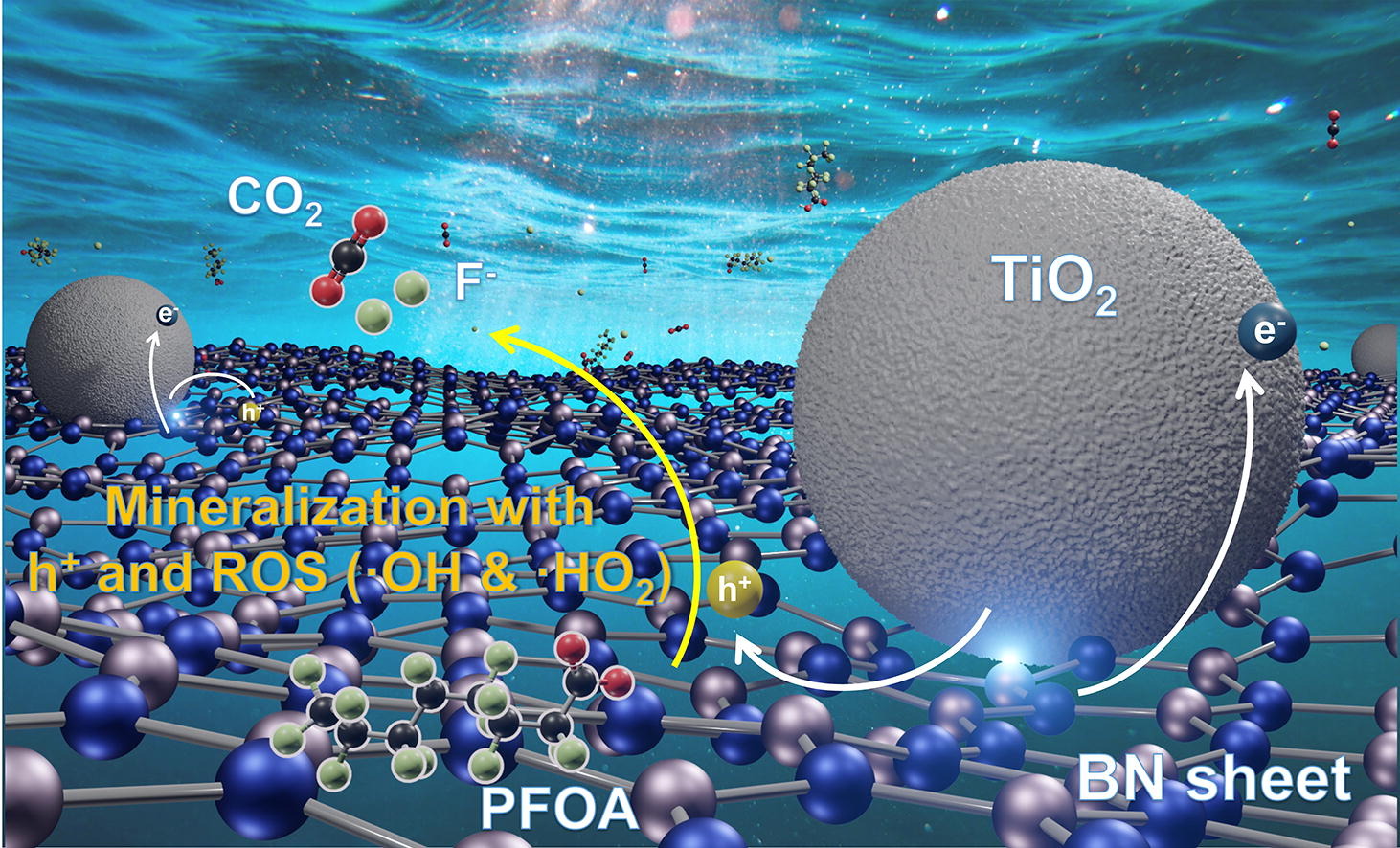博文
研究人员改进了用阳光摧毁“永久化学物质”的催化剂
 精选
精选
||
研究人员改进了用阳光摧毁“永久化学物质”的催化剂
诸平

据美国莱斯大学(Rice University)2022年7月25日提供的消息,莱斯大学的化学工程师改进了他们的光动力催化剂设计(Researchers improve catalyst that destroys 'forever chemicals' with sunlight),该催化剂可以快速分解全氟辛酸(perfluorooctanoic acid简称PFOA, Fig. 2),全氟辛酸是世界上最成问题的“永久化学”污染物之一。相关研究结果于2022年6月22日已经在《化学工程杂志》(Chemical Engineering Journal)杂志网站发表——Lijie Duan, Bo Wang, Kimberly N. Heck, Chelsea A.Clark, Jinshan Wei, Minghao Wang, Jordin Metz, Gang Wu, Ah-Lim Tsai, Sujin Guo, Jacob Arredondo, Aditya D. Mohite, Thomas P. Senftle, Paul Westerhoff, Pedro Alvarez, Xianghua Wen, Yonghui Song, Michael S.Wong. Titanium oxide improves boron nitride photocatalytic degradation of perfluorooctanoic acid, Chemical Engineering Journal, 15 November 2022 (Available online 22 June 2022), 448: 137735. DOI: 10.1016/j.cej.2022.137735. https://dx.doi.org/10.1016/j.cej.2022.137735
参与此项研究的除了来自美国莱斯大学的研究人员之外,还有来自中国环境科学院环境标准与风险评估国家重点实验室(State Key Laboratory of Environmental Criteria and Risk Assessment, Chinese Research, Academy of Environmental Sciences, Beijing, China)、清华大学(Tsinghua University, Beijing, China);美国休斯顿德克萨斯大学-麦戈文医学院(University of Texas-McGovern Medical School at Houston, TX, USA)以及美国亚利桑那州立大学(Arizona State University, Tempe, AZ, USA)的研究人员。
上述图1(Fig. 1)显示了一种包含氮化硼片(蓝色和银色球晶格)和二氧化钛(TiO2)纳米颗粒(灰色球体)的复合材料如何利用阳光中的长波紫外线能量光催化全氟辛酸(PFOA)分解为二氧化碳、氟和矿物质。
迈克尔·王(Michael Wong)和他的学生在2020年惊人地发现,氮化硼(boron nitride)是一种常用于化妆品的市售粉末,可以在暴露于波长为254纳米(λ=254 nm)紫外光下的几个小时内破坏99%的水样品(water samples)中PFOA。
上述研究论文的通讯作者迈克尔·王说:“这很好,因为PFOA是一种越来越严重的污染物,而且真的很难破坏。但它也不太理想,因为氮化硼能被短波紫外线激活,但大气过滤掉了几乎所有来自太阳光的短波紫外线。我们希望尽可能多地推动氮化硼获取能量的能力来自其他波长的阳光。”
长波紫外线(Long-wave UV)或UV-A的波长范围约为315-400 nm。它是导致晒黑和晒伤的原因,它在到达地球的阳光中非常丰富。氮化硼是一种半导体,它不会被UV-A激活。TiO2(titanium dioxide)是防晒霜中的一种常见成分,是一种可被UV-A激活的半导体,它甚至被证明在暴露于UV-A时会催化PFOA的分解,尽管速度很慢。
因此,迈克尔·王和该研究的共同主要作者王博(Bo Wang音译)、段丽洁(Lijie Duan)和 金伯莉·埃克(Kimberly Heck)决定创建一种氮化硼和TiO2复合材料,并结合各个催化剂的最佳特性。在他们的新研究中,他们表明UV-A驱动的复合材料破坏PFOA的速度比普通TiO2光催化剂快15倍。
通过分析光电流响应测量和其他数据,迈克尔·王的团队了解了其半导体复合材料如何收集 UV-A能量来分解水中的PFOA分子。在自然阳光下使用塑料水瓶(plastic water bottles)的户外实验中,他们发现氮化硼-二氧化钛复合材料可以在不到3小时的时间内降解去离子水中约99%的PFOA。在盐水(salty water)中,这个过程花了大约9小时。
越来越多的证据表明PFOA对人类健康有害。美国一些州对饮用水中的PFOA污染设定了限制,2021年3月,美国环境保护署(Environmental Protection Agency简称EPA)宣布了制定联邦标准的计划。
迈克尔·王说,制定PFOA标准的监管压力越来越大,因此水处理厂(water treatment plants)一直在寻找新的、具有成本效益的方法来从水中去除PFOA。
PFOA是最普遍的全氟烷基和多氟烷基物质(perfluoroalkyl and polyfluoroalkyl substances简称PFAS)之一,是20世纪开发的一系列化合物,用于制造防水服装、食品包装和其他产品的涂料。PFAS被称为永远的化学物质,因为它们不易降解并且往往会在环境中徘徊。迈克尔·王说,他的团队正在评估其复合光催化剂在分解其他PFAS方面的效果。
他说,氮化硼和这种复合催化剂技术已经引起了基于莱斯大学的纳米系统工程研究中心-纳米技术水处理(Rice-based Nanosystems Engineering Research Center for Nanotechnology-Enabled Water Treatment)几个工业合作伙伴的关注,该中心由美国国家科学基金会(National Science Foundation)资助,旨在开发离网水处理系统(off-grid water treatment systems)。
上述介绍,仅供参考。欲了解更多信息,敬请注意浏览原文或者相关报道。
Boron nitride destroys 'forever' chemicals PFOA, GenX
•BN/TiO2 composite was synthesized through simple calcination of nontoxic powders.
•BN/TiO2 is a type II heterojunction with improved charge carrier separation.
•Under UV-C, BN/TiO2 degraded short-chain PFOA intermediates faster than BN and TiO2.
•Under UV-A, BN/TiO2 degraded PFOA faster than TiO2, while BN was inactive.
Boron nitride (BN) has the newly-found property of degrading recalcitrant polyfluoroalkyl substances (PFAS) under ultraviolet C (UV-C, 254 nm) irradiation. It is ineffective at longer wavelengths, though. In this study, we report the simple calcination of BN and UV-A active titanium oxide (TiO2) creates a BN/TiO2composite that is more photocatalytically active than BN or TiO2 under UV-A for perfluorooctanoic acid (PFOA). Under UV-A, BN/TiO2 degraded PFOA ~ 15 × faster than TiO2, while BN was inactive. Band diagram analysis and photocurrent response measurements indicated that BN/TiO2 is a type-II heterojunction semiconductor, facilitating charge carrier separation. Additional experiments confirmed the importance of photogenerated holes for degrading PFOA. Outdoor experimentation under natural sunlight found BN/TiO2 to degrade PFOA in deionized water and salt-containing water with a half-life of 1.7 h and 4.5 h, respectively. These identified photocatalytic properties of BN/TiO2highlight the potential for the light-driven destruction of other PFAS.
https://m.sciencenet.cn/blog-212210-1349821.html
上一篇:用于更有针对性的癌症治疗的新型水凝胶
下一篇:石墨烯科学家首次捕捉到原子在液体中“游泳”的图像
